Air pollution and lichens
This is the audio (below) for this halt. The text below is a transcription of the audio! The audios do not contain all the content written in the text to keep the audios engaging. If you want to have more details, check out the text. Enjoy!
On your way to the canal, did you see flowers blooming through the crevices of the cement? Wilderness can be observed everywhere.

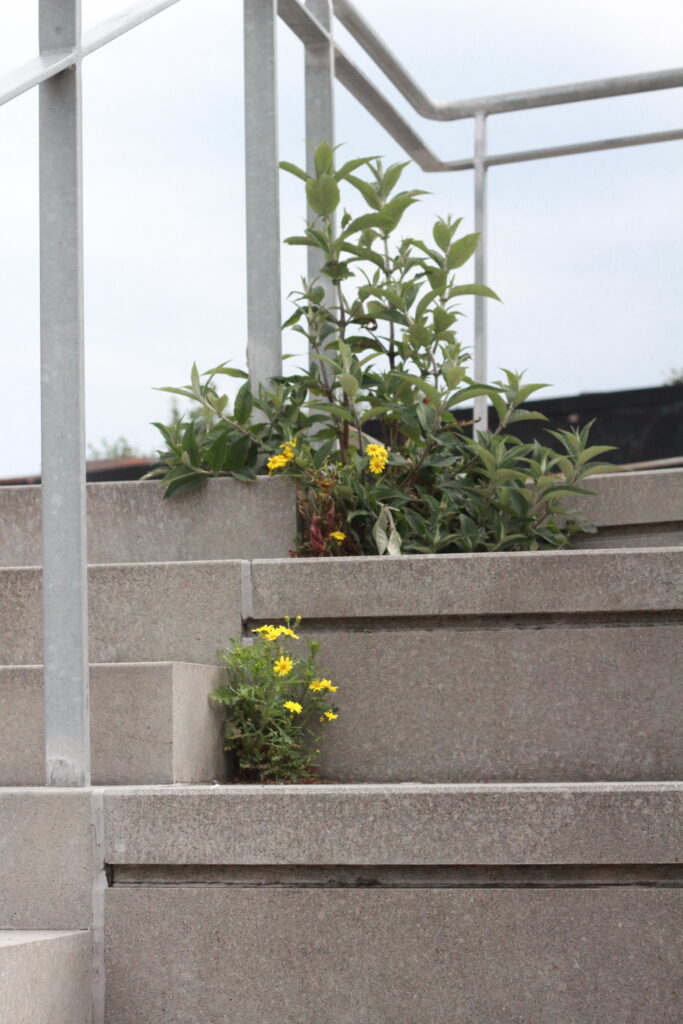
Credit: Flowers blooming through cement, picture taken by the author, Lucie Pestiaux (2021) under a CC BY-SA 4.0 license.
Welcome to the canal ! We are going to observe the third tree when you go towards the small park in front of the student accommodation. See the pictures below for more details.

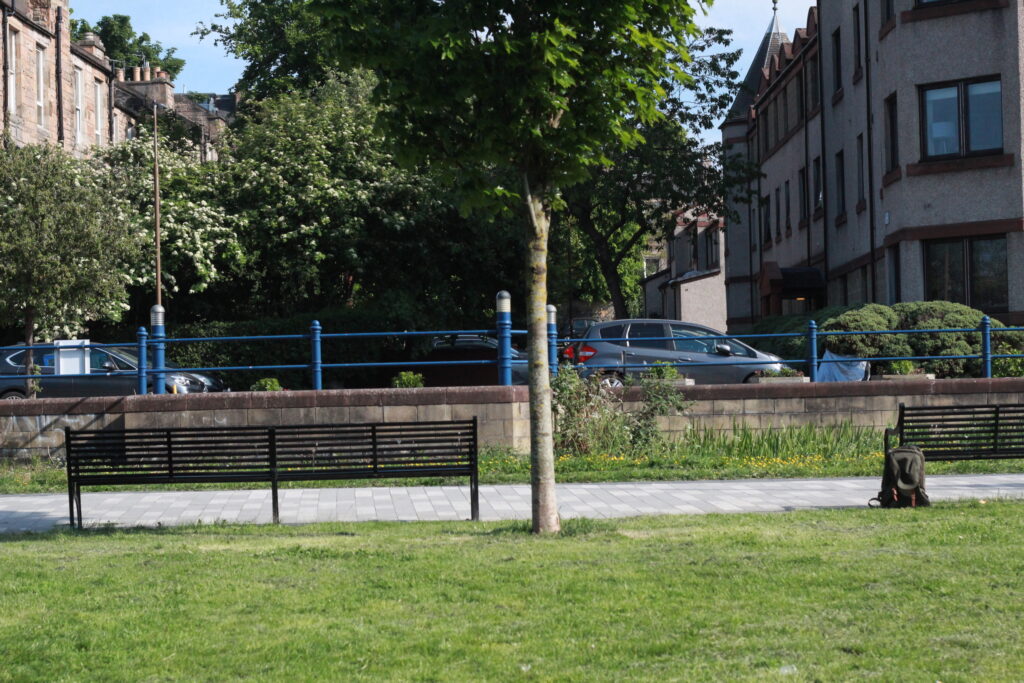
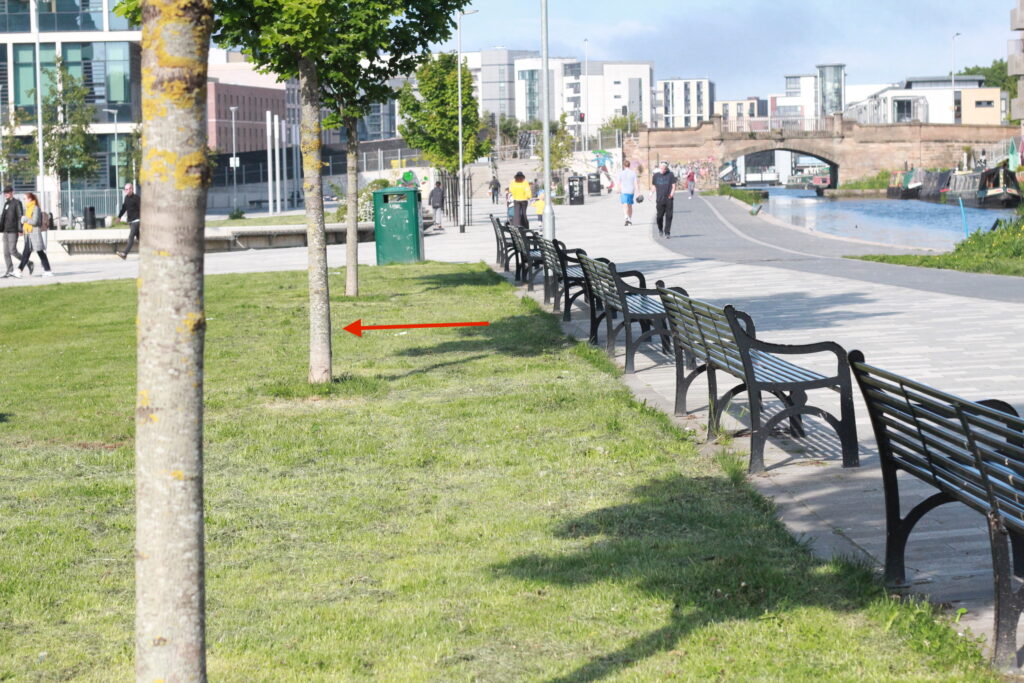
Credit: Position of the tree observed as part of the Lichen Walk on Fountainbridge green, picture taken by Lucie Pestiaux (2021). CC BY-SA 4.0.
What do you think is the link between lichens and air pollution?
As we said earlier an organism is affected by its environment and in turn alters its habitat. This is what ecologists study, the relationship between organisms and their environment. Thus, by recording the absence or presence of certain lichen species, we can get an idea of the state of the habitat.
Lichens, “like mosses, incorporate the material effects of urban ecologies across time and space and therefore form a process of bioindication in the city, capturing pollutants and transforming them into resources accessible to other organisms.”
Jennifer Gabrys, 2012 in “Becoming urban: sitework from a moss eye view“.
But what is bioindication?
Bio-indication is a process whereby environmental pollution becomes embedded in the bodies of and the relationships between organisms. These organisms express the accumulation of pollution through physiological or other observable changes.
Lichens are interesting for assessing pollution levels because they are sensitive to the air composition. The reasons are as follows:
- Lichens do not have roots – they have rhizines that allow them to attach to substrates – and therefore absorb the water and the solute substances from the air.
- Lichens do not have a protective layer – a cuticle – which means that pollutants can easily enter into the fungal and algae cells. In fact, unlike plants that have stomata, lichens do not have a system for regulating the entry and exit of gases and water in the thallus. As a result, lichens indiscriminately absorb all substances that reach them, both toxic and nutritious.
- Lichens are continuously active. All year round, from summer to winter, they are able to photosynthesise, even when temperatures are below -10°C. In winter, lichens are subject to increased pollution (e.g. increased use of electric heating) but still remain active.
- In addition, lichens grow very slowly so that any injury cannot be easily repaired. To give you an extreme example, the growth rate of lichens in harsh environments, such as continental Antarctica, is 1 cm per 1000 years.
We can assess the quality and composition of the habitat by observing the presence and/or absence of certain lichen species as well as changes in their forms. For example, in an old forest in Scotland where the air is clean, you will find many lichens of the genus Usnea (see photo) because these lichens are extremely sensitive to air pollutants such as nitrogen dioxide (mainly emitted by fuel combustion).
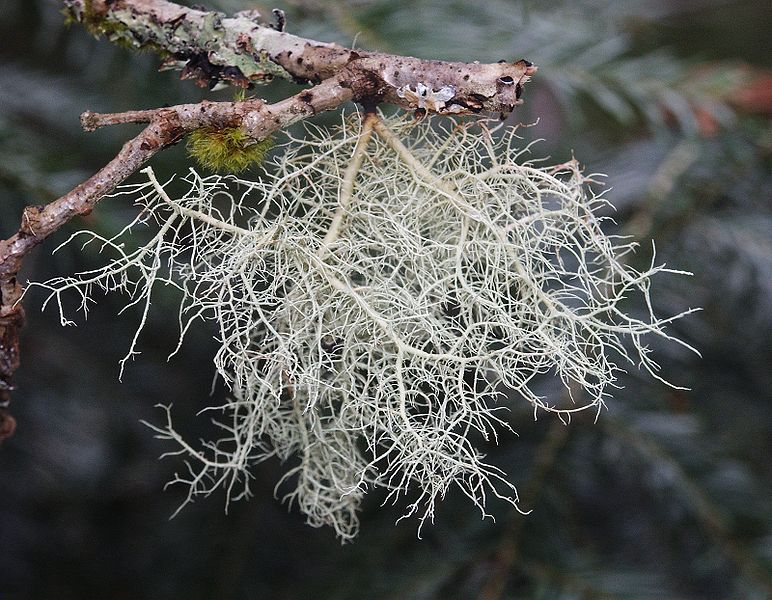
In cities, on the other hand, we find lichen species that are more tolerant to air pollution. The species that we have seen up until now are all tolerant to nitrogen dioxide (Xanthoria parietina, Punctelia subrudecta as well as others such as Physcia adscendens). What’s more, these species have varied tolerance to pollutants. For example, when Melanohalea species (spp) lichens are present (we will this lichen later on), the air quality will be intermediate. When Evernia prunastri or generally foliose species are present, the air quality is good.
The assessment of air quality through studying changes in the distribution and diversity of lichens is increasingly used in cities. If this is done regularly, one can even observe the potential changes in the air composition in the city over time.
For example, before 1990, sulphur dioxide (SO2), a pollutant emitted mainly by industries, was prevalent in many cities. In 1990, the Clean Air Act and an international treaty – similar to the Kyoto Protocol, a trade in carbon dioxide – were created to decrease the concentration of sulphur dioxide in the air. It worked seeing the change in lichen distribution in the cities around the world. Lichens that thrived in an environment with SO2gradually disappeared and other more sensitive lichens repopulated the cities. It is also interesting to think about the impact that reduced pollution has on more-than-human species and the legitimacy of valuing these non-polluted environments at the expense of other species.
Lichens can be affected by changes in their habitat on several levels. For example, temperature change, storms, heavy rainfall can affect lichen communities, as can the surface of a tree trunk. If a crack is created in certain places, it can change the way water flows down the trunk and affect the distribution of lichens. Small details matter.
For example, a study in England showed that lichen communities are different at the top of a church compared to its bottom, such as in the cemetery. This is partly due to the different air currents. Closer to the ground, the atmospheric pollution is captured by the buildings increasing the air pollution levels. The open flow of air at the top of the church creates a greater dilution of the atmospheric pollution which is thus less localised.
Lichens and citizen science
In the UK, the Natural History Museum in London created a project called OPAL (Open Air Laboratory based on Lichens). The project was based on citizen science. This means that citizens were involved in the data collection and were invited to record and observe lichen species in the area where they lived.
One of the benefits of citizen science is that it creates a huge database and a better understanding of the dynamics of our surrounding environment. Citizen science also allows citizens to be involved in understanding and observing their environment and learning from it.
This study, OPAL (Open Air Laboratory based on Lichens) allowed to observe several changes. Firstly, the fact that lichen species tolerant to NO2 (nitrogen dioxide) have become widespread throughout the UK, in cities and in the countryside. This could be caused by traffic, but also by the fertilisers used in fields for intensive agriculture. Some so-called intermediate lichens – which can live in more than one environment – have also been found in towns and cities and therefore have a widespread distribution.
Environmental pollution and its effects on humans
Air pollution has an impact on lichens but also on our health. Human exposure to pollution leads to respiratory and cardiovascular diseases; pollutant particles have also been found lodged in the heart and brain (Loxham et al., 2019). In Europe, 800,000 people die each year from pollution-related causes (Lelieveld et al., 2019). Pollution is a problem of environmental health as much as it is a problem of the health of our bodies (Gabrys, 2020).
This can lead us to rethink urban spaces and their infrastructure to make room for other organisms. We know that lichens, among other organisms, are impacted by changes in the infrastructure and management of the city. Hence, how can we, as urban residents, recognise the presence of other organisms in the city?
“It takes learning to recognise and be interrupted by the presence, strengths and forms of organisms of other species than humans and to notice the role they play in the construction and disruption of public places.”
Jennifer Gabrys, 2018
Identification
I would like to introduce you to two common lichens of the type crustose: Lecanora chlarotera and Lecidella elaeochroma. You will also see Xanthoria parietina that we have already identify and the species of the genus Physcia (see photo below for all the species together).

Lecidella elaeochroma. This lichen is crustose and has black apothecia (reproductive apparatuses that we will talk about later on in the walk) on an almost transparent white or greenish thallus. The lichen is often confused with Amandinea punctata. The two lichens can only be distinguished using chemical tests. The black lines that you see determined the separation between the different individuals. These structures are only made of fungal particles. This lichen is often found, along with Lecanora chlarotera (the white lichen next to Lecidella elaeochroma) in polluted environments.
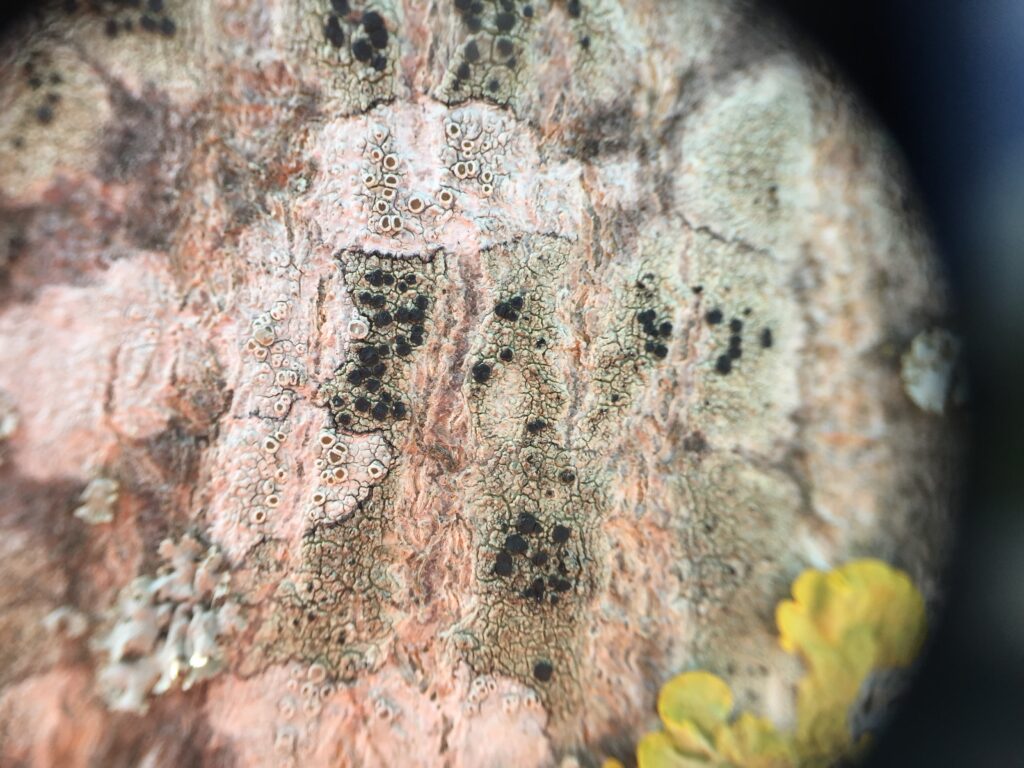
The picture below shows different crustose lichens close to one another. The small lichen with black dots (apothecia) and a white thallus is called Arthonia radiata. We can also see the apothecia of Lecanora chlarotera and an individual of Lecidella elaeochroma. Can you see those on the tree trunk?
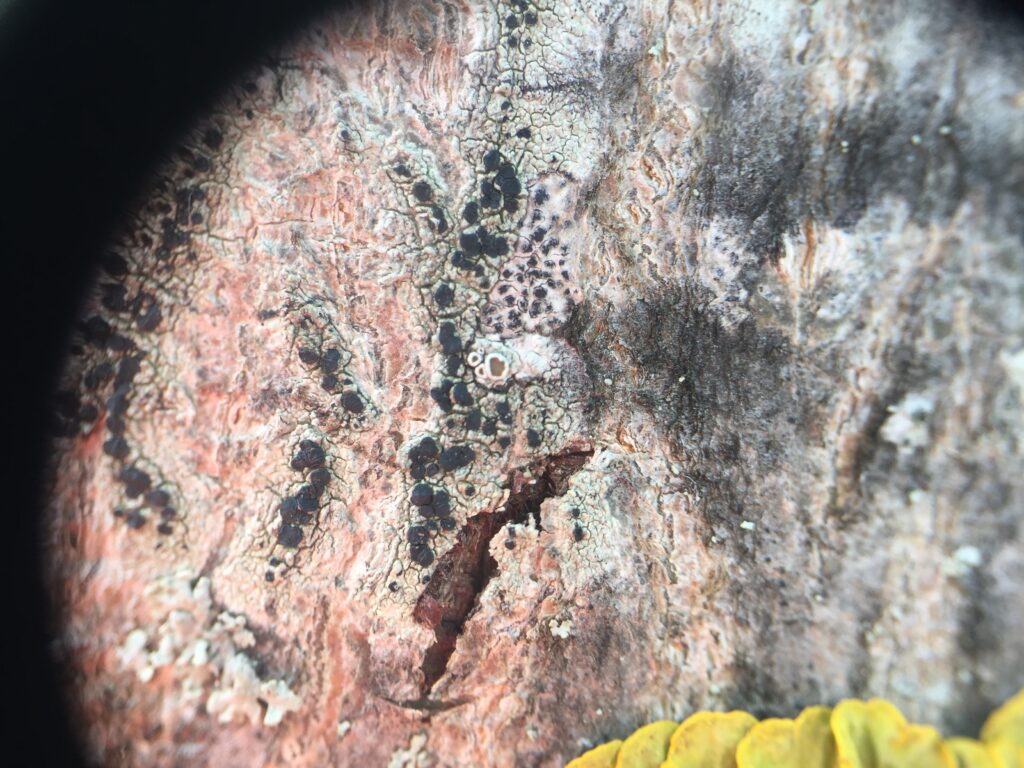
Lecanora chlarotera is another crustose lichen. It has a white thallus and apothecia (the reproductive apparatuses) that look like pie with borders (compared to the apothecia of Lecidella elaeochroma that are more rounded) and are brown inside. When the organism is very wet the apothecia can change shape due to the saturation with water. Apothecia are the structure that we can see going out of the thallus. We will talk about those later on this walk.
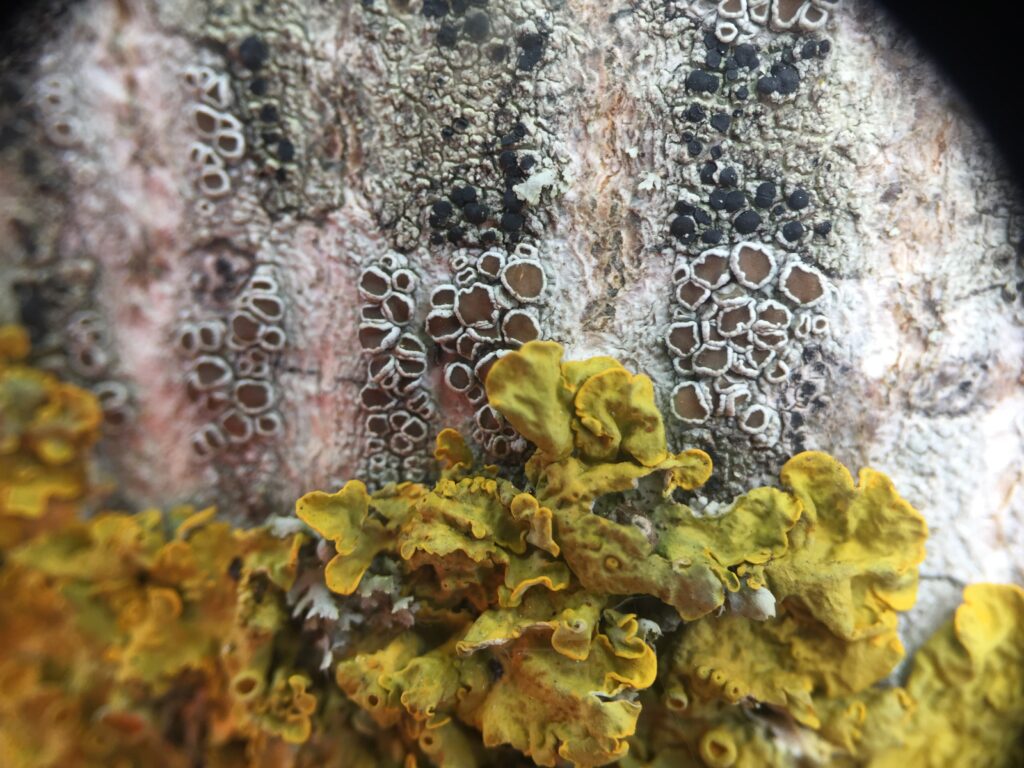
Activity
Are you motivated to try and explore the environment which you live in and evaluate the level of pollution? Let’s get started…
There are plenty of tools at your disposal even if you know nothing about lichens.
Check out this Air Survey booklet that was created for the OPAL Survey. More information on the OPAL project can be found here.
Let’s rethink the city together… How can we create cities that are inspired by and responsive to wildlife ? This is a challenge for all of us, city dwellers !
References
– Gabrys, J. (2018). Sensing Lichens: From Ecological Microcosms to Environmental Subjects. Third Text, 32(2-3), 350-367.
– Loxham, M., Davies, D. E., & Holgate, S. T. (2019). The health effects of fine particulate air pollution.
– Lelieveld, J., Klingmüller, K., Pozzer, A., Pöschl, U., Fnais, M., Daiber, A., & Münzel, T. (2019). Cardiovascular disease burden from ambient air pollution in Europe reassessed using novel hazard ratio functions. European heart journal, 40(20), 1590-1596.
Feedback
If you don’t continue the ride, can you give us feedback on your experience here ? It will help us improve!
Let’s meet at Dalry Park👇🏾👇🏾


